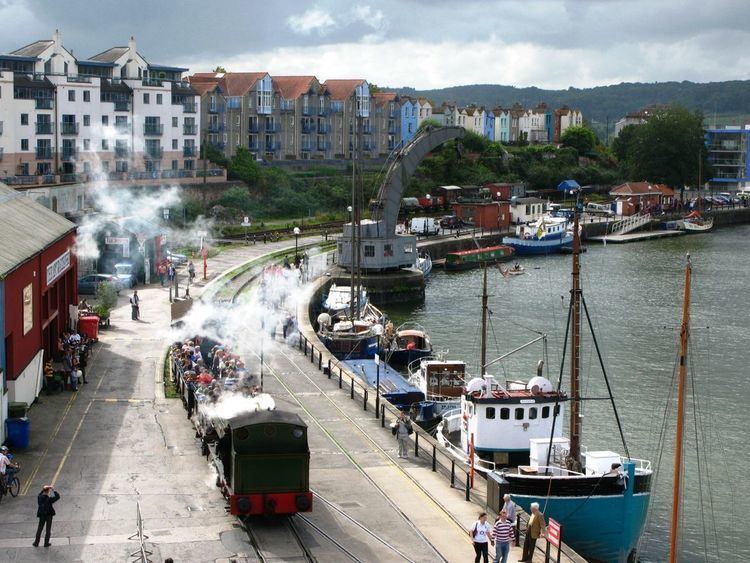Terminus Prince's Wharf Opened 1872 and 1906 | Stations 3 Phone +44 117 352 6600 | |
 | ||
Original gauge 4 ft 8 ⁄2 in (1,435 mm) standard gauge Preserved gauge 4 ft 8 ⁄2 in (1,435 mm) standard gauge Address Wapping Rd, Bristol BS1 4RN, UK Hours Closed today FridayClosedSaturday10AM–5PMSunday10AM–5PMMondayClosedTuesdayClosedWednesdayClosedThursdayClosed Similar | ||
Bristol harbour railway alfred judy visit sunday 15th september
The Bristol Harbour Railway is a heritage railway in Bristol, England operated by Bristol Museums Galleries & Archives. It runs for approximately 1 mile (1.6 km) along the south side of Bristol Harbour, starting at M Shed (the former Bristol Industrial Museum (51.4483°N 2.5969°W / 51.4483; -2.5969 (Bristol Harbour Railway (Prince Street end)))), stopping at the SS Great Britain, and ending at B Bond Warehouse (home of the Create Centre), one of the large tobacco warehouses beside Cumberland Basin (51.4466°N 2.6213°W / 51.4466; -2.6213 (Bristol Harbour Railway (Cumberland Basin end))).
Contents
- Bristol harbour railway alfred judy visit sunday 15th september
- Bristol harbour railway
- History
- Preservation
- Rolling stock
- References
Bristol harbour railway
History
The original Bristol Harbour Railway was a joint venture by the GWR and sister company the Bristol and Exeter Railway, opened in 1872 between Temple Meads and the Floating Harbour. Its route included a tunnel under St Mary Redcliffe church and a steam-powered bascule bridge over the entrance locks at Bathurst Basin. In 1876 the railway was extended by 1⁄2 mile (0.80 km) to Wapping Wharf.
By Act of Parliament of 1897, the GWR was authorised to make a westwards connection between the BHR and the Portishead Railway, and then create the West Loop at Ashton Gate which would face south towards Taunton and Exeter St Davids. This connection would allow a doubling of BHR rail access capacity to the Great Western main line. In 1906 this authorised extension was constructed, with new branches from the south via the Ashton Swing Bridge were built to: Canons Marsh on the north side of the Floating Harbour; and to Wapping via a line alongside the New Cut.
The Temple Meads connection was closed and the track lifted in 1964 (the bascule bridge engine survives in Bristol Museums). The Canons Marsh branch closed the following year, with the Canons Marsh goods shed is now the home of Explore At-Bristol, a hands-on science centre. The Western Fuel Company continued to use the branch from the Portishead line and Wapping marshalling yard for commercial coal traffic until 1987.
Preservation
In 1978, the preserved railway was established as an element of Bristol Industrial Museum using locomotives built in Bristol and formerly used at Avonmouth Docks. At first, it connected the museum with the SS Great Britain, but when commercial rail traffic ceased in 1987 the museum railway expanded to use the branch alongside the New Cut. When the Portishead Railway was relaid the connection at Ashton Junction was severed.
Today the railway operates on selected weekends on standard gauge track over 1 1⁄2 miles (2.4 km). The railway is currently in use as far as B Bond Warehouse (home to the Create Centre and Bristol Archives), 1 mile (1.6 km) from the museum. On the south side of the harbour the railway crosses Spike Island, the narrow strip of land between the harbour and the River Avon, and clings to the side of the river as far as the junction with the northern branch at the Cumberland Basin. The former route east over the Swing Bridge is now the Pill Pathway rail trail and cycleway.
In 2006, Bristol Industrial Museum was closed and the site redeveloped into M Shed Museum of Bristol. The railway continues to operate between SS Great Britain Halt and the Create Centre, and in 2011 the railway became part of M Shed's working exhibits.
In 2010, Bristol City Council, in partnership with other local councils in the area, proposed that the route of the railway should be used for a bus rapid transit route to serve the south-west of the city. In early 2013, a review of alternative routes recommended a route along Cumberland Road, Commercial Road and Redcliff Hill as the best alternative. This change of route means that the rapid transit buses would no longer use the railway.
Rolling stock
The steam locomotives were formerly part of the aborted preservation scheme at Radstock North. There is also a collection of wagons, some of which have been converted for passenger use while others are used for demonstration goods trains.
